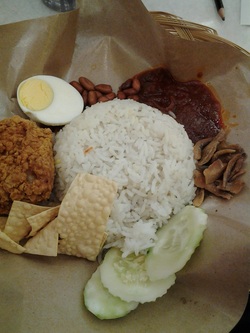
Anthony Bourdain raved about it when he was visiting Malaysia and people wonder why would anyone in their right mind would do so for a rice parcel that is literally translated to mean "Fat Rice" in Malay.
Nasi Lemak as the locals call it is indigenous to Malaysia and Singapore. It is not known to be found in Indonesia though a version of it, called Nasi Uduk, does exist and bears some passing resemblance.
But it would be foolish to think about the real origins of this dish as with all cuisines, the myriad of ingredients are a testament to the fusion of cultures that binds this dish together.
Fat Rice, is called such because it is made by boiling rice with Coconut Milk. Blue ginger (Galangal) is sometimes added to kick the taste up a notch along with some salt to taste. This coconut brew added to rice has to originate from Southern India, where they love adding copious amounts of that liquid to almost all types of dishes.
Another important element of the dish is the garnishing, where slices of cucumber is used. Cucumber, as any British soul would tell you, came from India.
Nasi Lemak as the locals call it is indigenous to Malaysia and Singapore. It is not known to be found in Indonesia though a version of it, called Nasi Uduk, does exist and bears some passing resemblance.
But it would be foolish to think about the real origins of this dish as with all cuisines, the myriad of ingredients are a testament to the fusion of cultures that binds this dish together.
Fat Rice, is called such because it is made by boiling rice with Coconut Milk. Blue ginger (Galangal) is sometimes added to kick the taste up a notch along with some salt to taste. This coconut brew added to rice has to originate from Southern India, where they love adding copious amounts of that liquid to almost all types of dishes.
Another important element of the dish is the garnishing, where slices of cucumber is used. Cucumber, as any British soul would tell you, came from India.
Then you have the hot chilli pepper paste called Sambal. If not for the Portuguese who came looking for spices in the 1500s, this killer condiment of Nasi Lemak would not have existed. The "sambal" element is what bind this whole dish together. The paste is loving crafted in the kitchen with prawn paste, chillies, onions and garlic. Dried anchovies are sometimes added to the sambal but often times, it is fried and presented as is.
The protein element of the dish is further enhanced with an egg. And the whole package is packed in a banana leaf parcel to keep them fresh and to enhance the taste. Banana leaf on rice is another South Indian influence of course but that's another story.
Normally, the rice parcel will be sold in this form without the papadums seen in this picture, or with the fried chicken. These are far too luxurious for peasants who often eat this food parcel as a snack or a meal.
Today, the variations in Nasi Lemak can be found everywhere in Malaysia and Singapore. The addition of meat dishes like curries and Rendang is probably too rich for the humble Nasi Lemak but some prefer it that way as can be seen by the rich variations found in Kopi Tiams (Asian style Cafe Bistros).
For many, the two elements in Nasi Lemak is the sambal condiment and the rice, which must be cooked to a precise method to bring out the wonderful aromas. Everything else is secondary. For the Indonesian version of Nasi Uduk, the dish is often eaten in the same way as Nasi Padang, where you have a wide choice of meat, seafood and vegetables to choose from. The best are often found on the streets of Jakarta and yes, Nasi Lemak and Nasi Uduk are considered Street Fare. It is a must try if you ever came round these parts.
The protein element of the dish is further enhanced with an egg. And the whole package is packed in a banana leaf parcel to keep them fresh and to enhance the taste. Banana leaf on rice is another South Indian influence of course but that's another story.
Normally, the rice parcel will be sold in this form without the papadums seen in this picture, or with the fried chicken. These are far too luxurious for peasants who often eat this food parcel as a snack or a meal.
Today, the variations in Nasi Lemak can be found everywhere in Malaysia and Singapore. The addition of meat dishes like curries and Rendang is probably too rich for the humble Nasi Lemak but some prefer it that way as can be seen by the rich variations found in Kopi Tiams (Asian style Cafe Bistros).
For many, the two elements in Nasi Lemak is the sambal condiment and the rice, which must be cooked to a precise method to bring out the wonderful aromas. Everything else is secondary. For the Indonesian version of Nasi Uduk, the dish is often eaten in the same way as Nasi Padang, where you have a wide choice of meat, seafood and vegetables to choose from. The best are often found on the streets of Jakarta and yes, Nasi Lemak and Nasi Uduk are considered Street Fare. It is a must try if you ever came round these parts.
 RSS Feed
RSS Feed